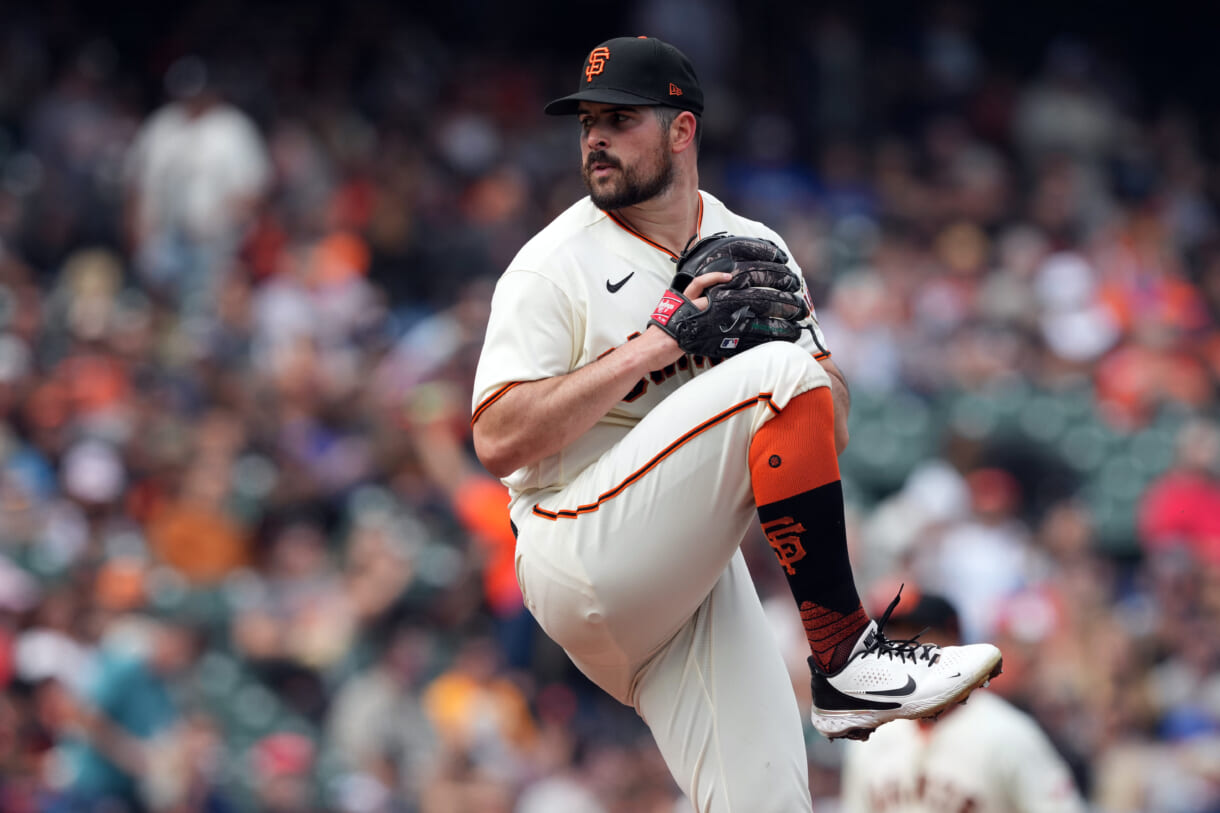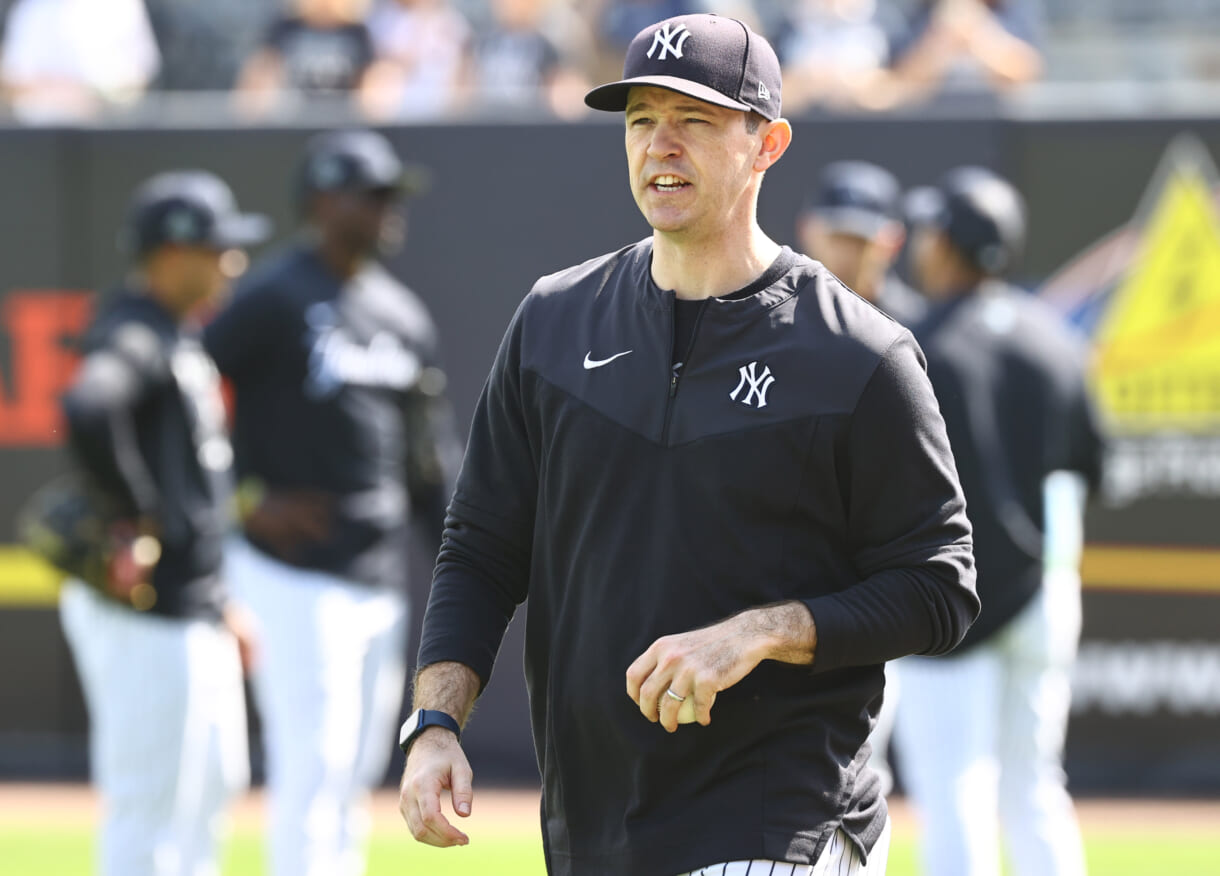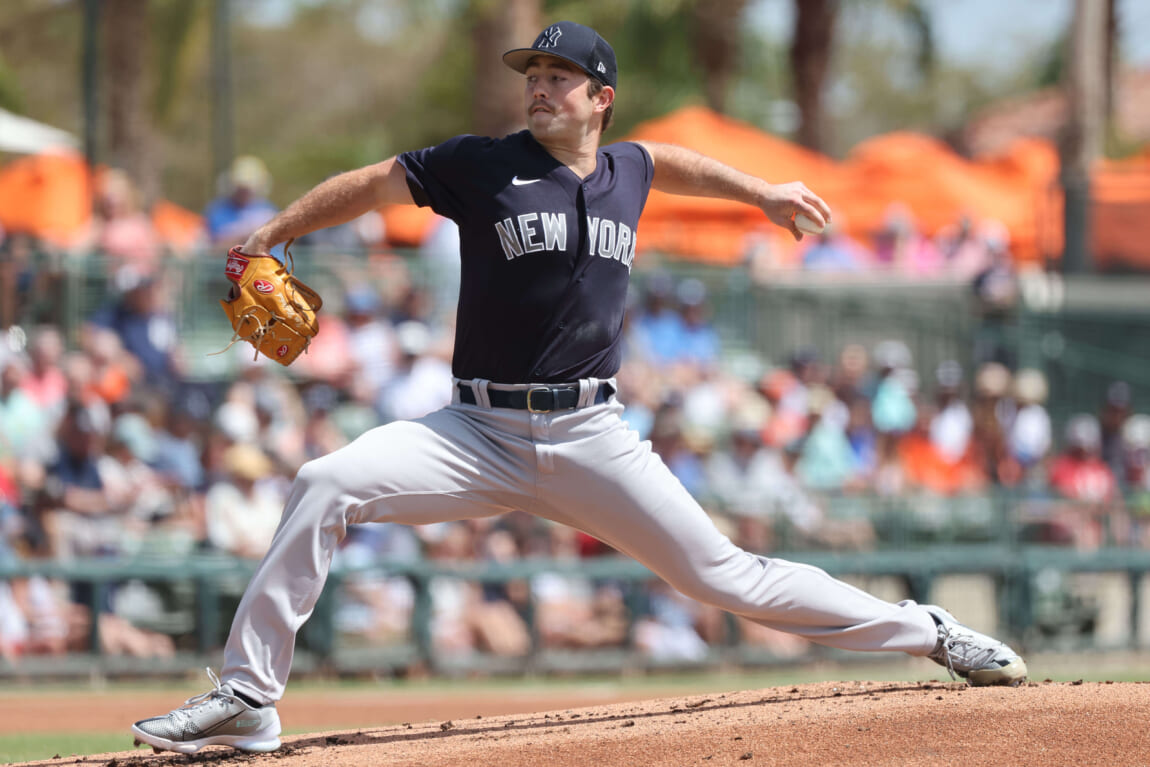
During the 2022 season, the Yankees found themselves having to trade struggling outfielder Joey Gallo. The Los Angeles Dodgers came calling and offered the Yankees a top-30 prospect in their organization. That prospect was RHP Clayton Beeter, who mightily struggled in the first half with a 5.75 ERA and 1.74 HR/9 through his first 18 outings and seemed destined to either being a reliever or flaming out. Maybe it was coaching, maybe it was a change of scenery, or maybe it was just dumb luck, but Clayton Beeter was dominant with the Somerset Patriots in Double-A after being traded, and now in 2023, he’s poised to take the prospect world by storm.
Despite great velocity and strikeout stuff, Clayton Beeter has flown under the radar in many Yankee circles. He’s someone who not only can fly up prospect boards but can also find his way into the Yankees’ 2023 roster at some point during the season.
- Yankees activate exciting outfield prospect off of IL, remains in Triple-A
- Yankees are ‘actively’ targeting help at 3B at the trade deadline
- The Yankees need to make a big push for this perfect infield trade target
Taking Huge Strides With the Yankees
If you look at Clayton Beeter’s numbers with the Dodgers in 2022, he was getting lit up like a Christmas tree for the entire season. He had a sparkling 21.7% K-BB%, but he had issues with command that could be seen in a 14.3% BB%. The other aspect of command that people can overlook is in-zone command, and it really showed up in the 1.74 HR/9 rate batters had against Beeter with LAD at the Double-A level. He knew how to generate strikeouts at an elite clip, with a 36.1% K% in his 51.2 IP. The problem was in polishing his pitch usage, and his command, something Director of Yankees Pitching Sam Briend, does excellently.
Formerly of Driveline and hired alongside beloved Pitching Coach Matt Blake, Briend has done a great job turning around or improving the careers of many pitching prospects the Yankees have rostered since 2020. The Yankees have dealt a lot of pitching talent in big deals like Ken Waldichuk, Hayden Wesneski, and JP Sears, so improving their current in-house talent is going to be important for their pitching depth. First step was helping Beeter manage the three true outcomes (K/BB/HR) significantly better, something we can not just see in those actual metrics but in a stat known as FIP.
- Splits with LAD and NYY
- K%: 36.1% -> 39.4%
- BB%: 14.3% -> 10.6%
- HR/9: 1.74 -> 0.36
- FIP: 5.07 -> 1.99
Beeter’s ERA going from 5.75 to 2.13 is no surprise when you see an improvement across the board in the three outcomes that a pitcher impacts the most, with the biggest improvement coming in HR prevention. This stems from a shift in batted ball splits, with batters hitting fewer flyballs and line drives and far more groundballs against the 23-year-old RHP. Going from a 36.4% GB% to a 45.8% GB% means even without any changes to your HR/FB ratios, your HR rates will drop due to fewer opportunities to even give up elevated contact that could leave the yard.
The Yankees did an excellent job identifying Beeter’s talent and helping him correct some of his core issues as a pitcher, but they’re not the only ones who deserve all the credit. Clayton Beeter himself boasts electric stuff and has always shown flashes of potential, so it’s not hard to see his path to success.
One of the Best Sliders in MiLB
Clayton Beeter was carving up hitters in AA with his slider, a pitch that he threw 36.8% of the time, making it his clear secondary pitch to his fastball. This pitch was clearly his best in 2022, as he generated a ridiculous 41.5% CSW%, which stands for ‘Called Strike + Whiff%’, a metric that correlates with run prevention for any given pitch/pitcher. Avoiding contact is a surefire way to find success at the Major League level, and the average CSW% for sliders in 2022 was 31.1%, telling you Beeter’s slider is just on a different level.
What makes Beeter’s slider so dominant is the strong vertical drop it gets, profiling as a gyro slider with that bullet-like spin. With -3.8″ of induced vertical break, it drops 4 inches more than the average slider in 2022 (1.8″ IVB), which allows it to play extremely well off of his four-seam fastball. Batters whiffed at his slider a whopping 54.1% of the time in 2022, posting just a .165 xwOBA on the pitch. He put up videogame numbers with the pitch, and it’s no wonder as to why he became a strikeout machine with the Somerset Patriots, as he seemed to rely on that pitch significantly more after being traded.
We previously mentioned Beeter’s newfound ability to keep the ball on the ground after being traded and improved launch angle management could be attributed to his slider. Sliders don’t typically produce many groundballs, as they’re typically infield flyball inducers, but perhaps the sharper break at above 85 MPH generates a lot of rolled-over contact. It generates over 24″ of vertical separation off of his FF, whereas the average vertical separation off of a FF is 14.3″, thus causing so many whiffs and weak grounders.
While his slider is one of the grossest sliders you’ll find anywhere in MiLB, and his fastball also generates great movement, but it lags behind in its results.
Improving Fastball Command
In-zone command is still important for pitches like fastballs that tend to get hit more than breaking balls or offspeed pitches. Beeter’s four-seam fastball got hit around last season for a .402 xwOBA and just a 26.6% CSW%, which is below the 27.8% average for FFs in 2022. It doesn’t reflect on the specs of the pitch, however, which would suggest that it’s a fastball that should generate a ton of swings and misses.
- 18.4″ Induced Vertical Break
- 6.5″ Horizontal Break
- 95.0 MPH
This fastball mirrors the fastball of newly-acquired All-Star Carlos Rodón, who’s FF pitch specs are nearly identical:
- 18.1″ Induced Vertical Break
- 5.8″ Horizontal Break
- 95.5 MPH

Rodón generated a .277 xwOBA against and 33.2% CSW% on his fastball in 2022, so why is Beeter struggling so much with a nearly identical fastball, albeit from the opposite hand? This doesn’t have to do much with the vertical approach angle of the pitch either, as Rodón has a -5.0° VAA on his fastball, a little steeper than the -4.8° VAA we see on FFs. He doesn’t rely on deceptively flat angles, so what separates the two pitches?
All of this boils down to command, which is a reoccuring theme in Beeter’s career. Incredible slider results should aid his fastball since it means hitters have to keep that slider in mind at any point of an AB. The strong induced vertical break means it should be a strong pitch to elevate for swings and misses and weak flyballs, and the tunnel for his FF and SL is already there.
When he’s able to locate that heater, it’s a nightmare for hitters who’ll have to make a split-second decision as to whether the pitch will drop off the table in the dirt for a or blow right by you upstairs. His impressive velocity is a huge part of this, showing the ability to reach back for 98 MPH when need be. Command is key here, as the stuff is already there for this pitch to succeed at any level he plays at.
We see that the Yankees have made it an emphasis in their rotation to have guys who can generate whiffs and do so with a riding four-seam fastball in their arsenal. Gerrit Cole, Carlos Rodón, Nestor Cortes, Luis Severino, and Frankie Montas all boast fastballs with above average Induced Vertical Break. Clayton Beeter looks to continue this trend, thought I imagine he won’t be contending for a rotation spot in March, barring injuries. There’s a clear philosophical idea the Yankees have as an organization with generating strikeouts, and that’s for very good reason.

Having a riding fastball like his should generate more success next season, and it’s in-line with the strikeout-centric development the Yankees have for their pitchers. The final aspect of Clayton Beeter’s game he needs to round out is how he handles opposite-handed batters, who gave him trouble in 2022 but could have that trend reversed quickly.
Handling Left-Handed Batters
Clayton Beeter absolutely carves up righties, as they posted just a .239 xwOBA and a 37.0% CSW% against Beeter for the entire 2022 season. Lefties, however, showed a lot more success against Beeter, with a .347 xwOBA against and 32.% CSW%, which isn’t terrible but also could be improved upon. The biggest difference between left-handed batters and right-handed batters are the chases, as LHBs chased at just 26.6% of pitches while RHBs chased at 31.4% of Beeter’s pitches. His arsenal should be able to handle lefties better in 2023 if his command strides are sustained, as his arsenal heavily depends on vertical deception.
RHPs tend to find a lot of success against LHBs with pitches that boast impressive vertical movement, as LHBs read horizontal movement a lot better against opposite-handed pitching. The pitch we’ve yet to discuss is Beeter’s curveball, which he used 17.1% of the time but got a gross 59.7% Whiff%. It’s slower than his slider at 82.6 MPH, but it drops more at -6.2″ of Induced Vertical Break. Batters weren’t chasing as much against it (28.2% Chase%), but it does serve a purpose to drop a curveball like his in every now and then.
I’ve gushed about the vertical separation on his FF and SL, but that’s because I believe we could see him find greater success with those pitches against LHBs. They’re perfect for handling lefties, and that’s going to play a huge role in whether Beeter sticks as a starter or not. It’s not like he’s struggling to get whiffs against lefties, he’s just struggling to get them to expand the zone, which is something that we saw him improve upon when he went to Somerset. His K-BB% was nearly 30% with the Yankees, and that’s not something you can achieve without finding improved success against lefties.
With his impressive stint in Somerset, the assumption that he’ll inevitably have to become a reliever can be challenged. Sticking as a starter is more than just putting up great per-rate metrics, so how can he handle a starter’s workload?
Clayton Beeter’s Viability As a Starter
At first, glance, tossing just 25.1 innings in 7 starts would suggest that you’re more of an opener or long reliever, but he slowly progressed deeper into starts as the Yankees saw better progress. He has yet to pitch 6 innings in an outing while part of the Yankee organization, but that seems to be part of their developmental path. They’re taking it easy with Beeter, who’s going to begin his age-24 season in 2023. This is eerily similar to how how they worked Ken Waldichuk up to a starter’s role this year before dealing him to Oakland. Waldichuk burst onto the scene in 2021 with impressive strikeout numbers and middling command, just like Beeter did in 2022.

The Yankees saw Beeter complete two 5-inning starts in consecutive in his final regular-season start and his only postseason start for the Eastern League Champion Patriots. In those starts, he was remarkable, albeit with some walk issues:
- 10 IP
- 1 ER
- 5 BB
- 13 K
- 4 H
2023 will be a pivotal year for Beeter’s viability in the rotation, but he’s passed the initial tests thrown at him. He’s got the stuff to handle it, and his arsenal should continue to evolve alongside his command to make him capable against all types of hitters. His command’s always going to be shaky, but I don’t think it’s crazy to compare him to Waldichuk, who didn’t get that national top-100 prospect attention until his age-24 season. We’re looking at a guy who came from the Dodgers organization just two years after being a top 70 overall pick in his draft class.
The Dodgers really liked him for a reason, and as he continues to add velocity and finesse to his game, he’ll continue to blossom as a starter. This isn’t to say this is a lock, and Beeter, quite frankly, can easily become a top-of-the-line reliever, but why not challenge him and the organization with the task of making him a full-time starter who could potentially make some spot starts late in the season for the MLB team?
Making An Impact on the 2023 Yankees?
I have made it a point of emphasis to discuss the role the Yankees’ farm system will play in their success in 2023. Clayton Beeter isn’t an exception to this, although he isn’t currently on the 40-Man Roster since he wasn’t Rule-5 eligible. He’ll need time at Triple-A before getting a look at MLB action, and the Yankees have guys in their farm that are farther ahead on the pitching side of the ball. That being said, with a strong start to his 2023 season (similarly to Waldichuk), he’s going to force his way onto an MLB roster one way or another.
Steamer loves Clayton Beeter, though they view him as someone who won’t pitch much for the 2023 team. In 14 projected innings, they think this is what he’ll produce:
- 3.58 ERA
- 3.64 FIP
- 3.62 xFIP
- 28.0% K%
- 9.8% BB%
When you look at his surface-level ERA at Double-A, a 4.50 ERA shouldn’t produce such strong projections, right? Well, that’s where strikeouts, walks, and home runs are so important. ERA will fluctuate no matter what, but if you’re keeping those three metrics steady, you’ll usually find success at the Major League level. This is what makes Beeter so enticing, and he could crack the top-100 lists by the All-Star Break if he’s able to continue the success he’s had in his short time with the Yankees.
There’s so much talent in that arm, and the upside could be a high-octane starting pitcher down the line. For now, Beeter could be a weapon late in the season for the Yankees out of the bullpen in a multi-inning role. The Astros have frequently used young starters in reliever roles before fully transitioning them to a permanent spot in the rotation, and that’s the path we could see for Beeter.
There’s already some buzz around Beeter being generated as the offseason continues and trade talks begin, but there’s still time to get on the bandwagon early. By the summer, I anticipate most of the prospect world is going to know Clayton Beeter and generate excitement about his development, and maybe he’s going to have a memorable strikeout in a huge playoff game next fall.